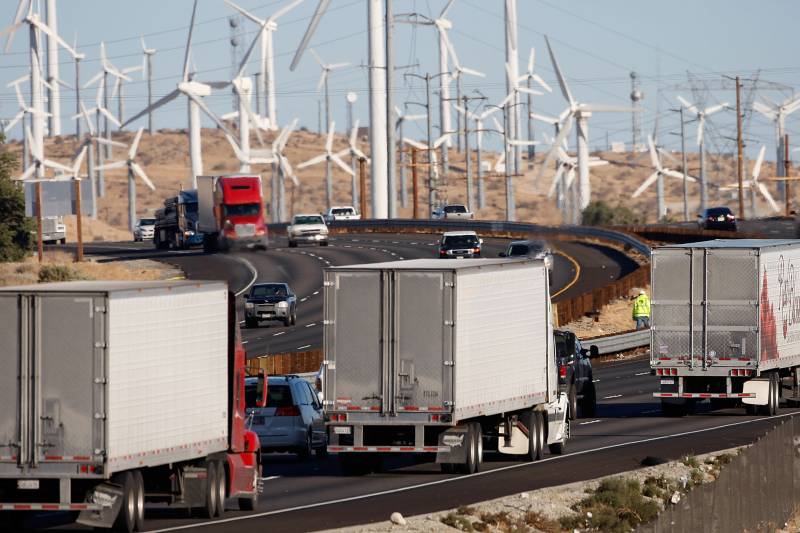California air regulators on Wednesday released a final draft of the state’s new climate blueprint, charting an ambitious path to dramatically reduce planet-warming gas emissions over the next two decades.
California Releases Sweeping New Climate Action Plan to Reach Carbon Neutrality

The plan would siphon down the state’s use of fossil fuels almost entirely and paints a not-too-distant picture of what Gov. Gavin Newsom said is a “pollution-free future.”
“It’s the most ambitious set of climate goals of any jurisdiction in the world, and if adopted, it’ll spur an economic transformation akin to the industrial revolution,” Newsom said in a statement emailed to reporters.
His administration is billing it as the world’s first “achievable roadmap to implement carbon neutrality,” from a major economy. But nothing in this document will be easy for California. Nor is it guaranteed to succeed.
The plan, drafted by the state Air Resources Board, calls for slashing greenhouse gas emissions below 1990 levels by 48% by the year 2030 and 85% by 2045 (so far, the state has cut its carbon pollution by just 3% — and recent research from a UCLA-led study suggests those gains might have been wiped out by the firestorms of 2020).
California would need to add tens of millions of electric cars to its roads and be using a tenth of the liquid petroleum, gas and diesel it uses today in a little more than two decades.
State officials said the backbone of the transition is a “clean, affordable and reliable grid,” and the policy framework includes a commitment to build no new gas plants. Instead, the state will meet the increased demand for electricity with renewable energy. To do that, California will need to build more wind and solar at a highly expedited rate, quadrupling its current capacity.
To keep the lights on, California will need to double its existing electricity generation capacity. The state narrowly avoided rolling blackouts this year after electricity demand nearly surpassed supply during a heat wave that baked the state for 10 days in September.
Lauren Sanchez, the governor’s climate adviser, acknowledged on a call with reporters that “this plan will indeed be very difficult to achieve because of the scale of the task and the speed with which it needs to be delivered.”
But, she said, “the governor will not take failure as an option, and neither should any of us.”
A more aggressive plan
The state’s powerful air board circulated a preliminary draft of the plan early in the year with the goal of 40% emissions reductions by 2030, but Gov. Newsom asked the agency to be more aggressive.
While the board hashed out the details over the course of months, California passed regulations to phase out the sale of new gasoline-powered cars.
And Newsom signed a series of aggressive climate bills into law setting new targets for clean energy and carbon sequestration on natural and working lands, establishing new rules on existing oil wells near neighborhoods and schools and expanding carbon capture and removal.
The latest draft incorporates these new efforts and others on offshore wind, clean fuels and climate-friendly housing construction.
But advocates and environmentalists want the state to move even faster, and have pressed for more aggressive targets.
Ellie Cohen, CEO of policy nonprofit The Climate Center, and UC Berkeley professor Dan Kammen argued in an opinion piece last week for California’s target to be “at least 55% below 1990 levels by 2030.”
They also criticized the state for what they said is “gambling on carbon capture and storage, a failed and expensive technology that perpetuates pollution in frontline communities.”
Reached by email on his way back from the COP27 climate summit in Egypt, Kammen said that the state’s latest version still relies too much on these technologies.
‘The harsh grip of petroleum’
In 2006, Republican Gov. Arnold Schwarzenegger signed AB 32, the Global Warming Solutions Act, into law, which mandated that the state produce a climate change road map every five years. The air board released the first plan in 2008, and this is its third update.
Board Chair Liane Randolph told reporters that this update “is far and away the most important and the one with the most ambitious targets.”
“We need to take action to reduce the worst impacts of a changing climate,” Randolph said. “And there is only one way to do that: Break forever our dependance on fossil fuels, the harsh grip of petroleum, and move as fast as we can to a clean energy economy. And that’s what this plan does. It delivers a massive reduction of climate-warming pollution.”
The state estimates it would cut air pollution by 71% and save Californians $200 billion in health costs due to pollution, while creating 4 million new jobs.
